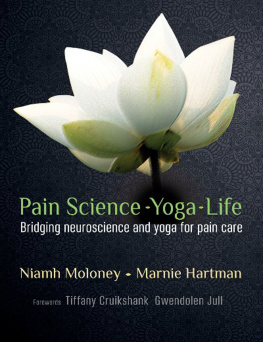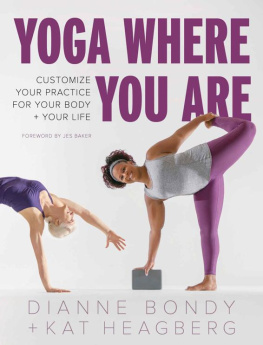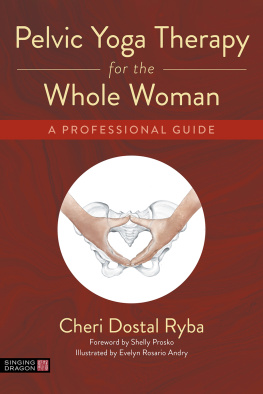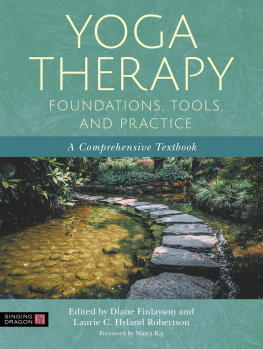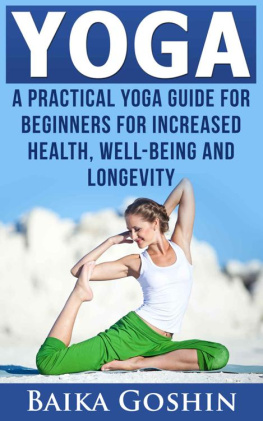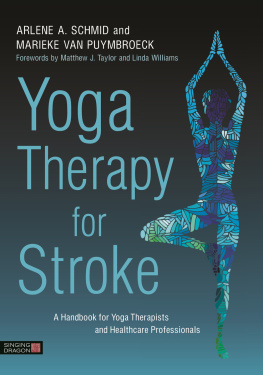THE
PRINCIPLES
AND
PRACTICE
OF YOGA IN
HEALTH CARE
Sat Bir Singh Khalsa Lorenzo Cohen
Timothy McCall Shirley Telles
Forewords by
Dean Ornish MD and Belle Monappa Hegde MD, PhD, FRCP, FACC

HANDSPRING PUBLISHING LIMITED
The Old Manse, Fountainhall,
Pencaitland, East Lothian
EH34 5EY, UK
Tel: +44 1875 341 859
www.handspringpublishing.com
First published 2016 in the United Kingdom by Handspring Publishing
Reprinted 2016
Copyright Handspring Publishing Limited 2016
All rights reserved. No parts of this publication may be reproduced or transmitted in any form or by any means, electronic or mechanical, including photocopying, recording, or any information storage and retrieval system, without either the prior written permission of the publisher or a license permitting restricted copying in the United Kingdom issued by the Copyright Licensing Agency Ltd, Saffron House, 610 Kirby Street, London EC1N 8TS.
The right of Sat Bir Singh Khalsa, Lorenzo Cohen, Timothy McCall, and Shirley Telles to be identified as the Editors of this text has been asserted in accordance with the Copyright, Designs and Patents Acts 1988.
ISBN 978-1-909-141-20-9
British Library Cataloguing in Publication Data
A catalogue record for this book is available from the British Library
Library of Congress Cataloguing in Publication Data
A catalog record for this book is available from the Library of Congress
Notice
Neither the Publisher nor the Editors and Authors assumes any responsibility for any loss or injury and/or damage to persons or property arising out of or relating to any use of the material contained in this book. It is the responsibility of the treating practitioner, relying on independent expertise and knowledge of the patient, to determine the best treatment and method of application for the patient.
We would like to acknowledge Kelly Birch for her dedication and expertise in assisting us with text development and for copyediting the book with such diligence and insight.
Commissioning Editor Sarena Wolfaard
Copy Editor/Developer Kelly Birch
Project Manager Joannah Duncan
Design Bruce Hogarth, kinesis-creative.com
Indexer Laurence Errington
Typesetter DSM Soft
Printer Dimograf, Poland
The
Publishers
policy is to use
paper manufactured
from sustainable forests
|
|
CONTENTS
SBS Khalsa S Telles L Cohen T McCall
R Sovik AB Bhavanani
T McCall L Satish S Tiwari
L Schmalzl CC Streeter SBS Khalsa
L Uebelacker H Lavretsky G Tremont
K Pilkington PL Gerbarg RP Brown
S Varambally BM Kutty BN Gangadhar
EJ Roseen RB Saper KJ Sherman
H Cramer SH Moonaz SJ Bartlett
E Kozasa D Santaella S Mishra B Trikamji
KE Innes TK Selfe FM Hecht
K Yang J Rioux
A Kanmanthareddy K Madan SC Manchanda D Lakkireddy
DL Cohen M Hagins
L Bernardi NF Bernardi G Passalacqua
SC Danhauer SJ Sohl EL Addington A Chaoul L Cohen
SN Culos-Reed R Long AA Walter M Van Puymbroeck
S Evans ML Galantino K Lung L Zeltzer
S Telles N Singh N Patel
C Booth-LaForce L Taylor-Swanson R Nagarathna R Chaku
A Ross A Michalsen
T McCall L Blashki S Tiwari J Kepner L Fishman
SBS Khalsa S Telles L Cohen T McCall
This is an extraordinary book. The authors have curated an extensive selection of research, providing the first state-of-the-art review of yoga therapy as an edited, scholarly, medically oriented textbook with a strong evidence-based focus on research and practice. There is strong representation internationally from both leading yoga researchers and yoga therapists.
There are introductory and concluding sections, examining the background of the subject and providing a perspective on the future. In the body of the book, 60 research scientists have contributed 17 chapters describing the scientific rationale and research evidence for yoga therapy in a variety of conditions. Each chapter includes two senior research investigators in the field in order to ensure a balanced representation and also stronger authority. In addition, 30 experienced yoga therapists have appended to the chapters their perspectives on how to translate this research evidence into practical, clinical applications.
We tend to think of all advances in medicine as being high-tech and expensive, such as a new drug, laser, or surgical procedures. We often have a hard time believing that something as simple as comprehensive lifestyle changes can make such a powerful difference in our livesbut they often do. In our own research, at the Preventive Medicine Research Institute in the United States, we have used some high-tech, expensive, state-of-the-art scientific measures to prove the power of some simple, low-tech, and low-cost interventions. These include:
yoga (gentle stretching, breathing techniques, meditation, and imagery);
a whole foods, plant-based diet (naturally low in fat, sweeteners, and refined carbohydrates);
moderate exercise; and
social support and community (love and intimacy).
In shorteat well, move more, stress less, and love more.
This lifestyle program is based on what I learned from Sri Swami Satchidananda, an ecumenical spiritual teacher with whom I had the privilege of studying, beginning in 1972. He taught me the importance of addressing the underlying causes of many chronic diseases: For most people, our natural state is to be easeful and peaceful. We are born with ease until we disturb it by making unhealthy lifestyle choices and become dis-eased. We are born fine until we allow ourselves to become de-fined. In other words, yoga and meditation do not bring us health and well-being. Rather, they help us to identify and change behaviors, diet, and perceptions that disturb our inner peace, joy, and well-being, thereby allowing our bodies exquisite healing mechanisms to work optimally.
For almost four decades, I have directed clinical research with my colleagues at the non-profit Preventive Medicine Research Institute and the University of California, San Francisco, proving the many benefits of these comprehensive lifestyle changes. These randomized controlled trials and other studies have been published in the leading peer-reviewed medical and scientific journals.
In addition to preventing many chronic diseases, comprehensive lifestyle changes can often reverse the progression of these illnesses. Our bodies often have a remarkable capacity to begin healing, and more quickly than we had once realized, when we address the underlying lifestyle causes of health and illness.
We proved in randomized controlled trials, for the first time, that lifestyle changes alone can reverse the progression of even severe coronary heart disease. There was even more reversal after 5 years than after 1 year and 2.5 times fewer cardiac events. We also found that these lifestyle changes can reverse type 2 diabetes and may slow, stop, or even reverse the progression of early-stage prostate cancer. And what is true for early-stage prostate cancer is likely true for early-stage breast cancer as well.
Changing lifestyle actually changes your genesturning on genes that keep you healthy, and turning off genes that promote heart disease, prostate cancer, breast cancer, and diabetesover 500 genes in only 3 months. People often say, Oh, its all in my genes, theres not much I can do about it. But there is. Knowing that changing lifestyle changes our genes is often very motivatingnot to blame, but to empower. Our genes are a predisposition, but our genes are usually not our fate.
Next page


